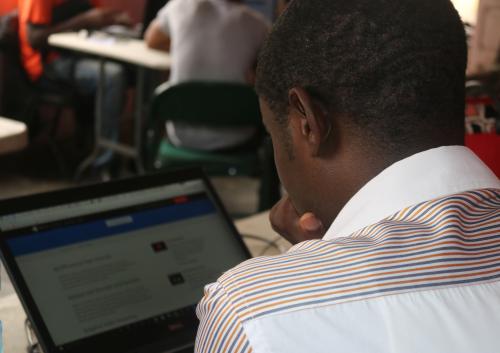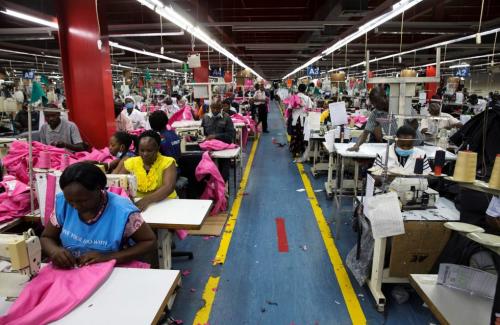The one subject that keeps many policymakers across African countries awake at night is “jobs.” How do we create decent jobs for the continent’s growing and youthful population? In the era dubbed the “Fourth Industrial Revolution,” in which the adoption and diffusion of technology is generating anxiety about the displacement of manufacturing and low- and middle-skilled service jobs, this question is even more complicated.
Leaders should not be afraid of the future of work, though: Digital technologies may have less of the feared displacement effect in African labor markets given that close to 80 percent of Africans are employed in low-wage informal work, and the manufacturing sector, which hosts the jobs most easily replaced by automation, accounts for just about 10 percent of overall employment, as found in a new World Bank report, “The Future of Work in Africa: Harnessing the Potential of Digital Technologies for All.” Rather, digital technologies have the potential to create new, more productive jobs in many African countries.
Then again, African countries are not out of the woods. Significant labor displacement due to technological change may not be a key risk, but there are others that are very salient. There are current and future risks from climate change and fragility, adjustment costs from regional and global economic integration, and rapidly changing demography. To harness the opportunities of digital technologies to create more and better jobs in African countries and to mitigate risks to labor markets from other “mega trends,” productive investments by public and private stakeholders are needed.
Risks in the formal and informal economy raise the need for social protection systems
So, how do we finance the much-needed strengthening and expansion of social protection systems required to more effectively help workers manage risks in the formal and informal economies? Indeed, many Africans—especially working-age people most at risk in the changing world of work, young people, and those in the informal sector—are not covered by social protection. By one estimate, this number is about around 80 percent of the population. Yet, the global policy discussions on the “future of work in Africa” have focused little on the crucial matter of how to secure the resources for these productive investments.
As the recent World Bank publication “Protecting All: Risk Sharing for a Diverse and Diversifying World of Work” argues, the time is ripe to think about an expansion of safety nets, social insurance, and labor market programs in ways that are independent of how and where people work and that respond to the fluid and diverse nature of work that will continue to be the norm in the region.
The question of how to secure resources to manage risks is a salient and perplexing one in African countries. To begin, the baseline of social protection coverage in sub-Saharan Africa is low: Eight in 10 people are not covered by any pension, safety net, or social protection program (Figure 1).
Figure 1: Most of sub-Saharan Africa is not covered by any social protection and labor (SPL) program
 Source: World Bank Atlas of Social Protection (ASPIRE) database.
Source: World Bank Atlas of Social Protection (ASPIRE) database.
But how do we pay for social protection systems?
To address this fiscal challenge of mitigating risk in a changing world of work in Africa, two categories of solutions should be considered.
First, governments should aim to increase investments in social protection by mobilizing revenue from domestic sources. In 2018, governments in Africa spent an average of $16 per capita on social safety nets in purchasing power parity terms, much lower than South Asia’s $29 and the global average of $80. Tax reforms can help raise between an additional 3 and 5 percent of GDP ($50 billion and $80 billion, respectively) in sub-Saharan African countries. In addition, there are several administrative and policy opportunities to optimize the revenue potential across many African countries (Figure 2)—including efficiency gains by moving toward the frontier of digital revenue administration, allowing, for instance, better administration of value-added taxes. Other strategies might include strengthening underused tax instruments such as excise taxes on cigarettes, alcohol, and luxury goods as well as property taxes; broadening the tax base by removing cost-ineffective tax incentives; and closing international tax loopholes for aggressive avoidance and evasion by multinationals and wealthy individuals.
Figure 2: The performance of different tax types in sub-Saharan Africa has improved, but many economies have significant potential to collect more revenue
Note: PIT: Personal Income Tax; CIT: Corporate Income Tax; VAT: Value-added Tax
Source: Choi, Jieun; Dutz, Mark; Usman, Zainab (2019). “The Future of Work in Africa: Harnessing the Potential of Digital Technologies for All.” Washington, DC: World Bank.
Even when significant resources are devoted to social policies, inefficiencies in actual spending often arise. These inefficiencies include overlapping programs, such as parallel administrative systems for processing health-fee waivers and cash transfers; relatively generous pension systems that serve only a small portion of the population and not necessarily the most vulnerable; and explicit or implicit subsidies across the economy that are distortive, expensive, and regressive.
Thus, a second solution might be to improve the allocation and efficiency of current social protection expenditures. Such strategies might include leveraging digital solutions to harmonize and expand social protection programs run by governments—including those supported by development partners, which fund more than half of social safety nets in many African countries—and by extending coverage to young people especially in the informal sector.
It is not uncommon for political resistance to emerge in the provision and extension of social protection for those most vulnerable to risks in the labor market. Therefore, African governments need to be able to expediently manage policy tradeoffs in mitigating risks for the poor, the young, and informal sector workers who are less likely to have strong political influence. Public expenditure reviews can identify opportunities to rebalance social spending towards people most at risk in some African countries where employee compensation consumes up to a third of government spending.
In short, thinking about the present and future of work in Africa requires putting social protection front and center of the economic—not only the social—agenda. The integration of social protection programs into broader national and regional economic strategies would be a first step, ensuring that these programs are not standalone initiatives vulnerable to political winds. Beyond strategies and national plans, countries in the region and the international community will need to step up their financing efforts to be able to help prepare African citizens for change.
For more on these and related issues, see the recent Brookings Africa Growth Initiative-World Bank event on digitization’s implications for the future of work.
The Brookings Institution is committed to quality, independence, and impact.
We are supported by a diverse array of funders. In line with our values and policies, each Brookings publication represents the sole views of its author(s).










Commentary
Show me the money: How do we finance social protection for the future of work in Africa?
December 12, 2019